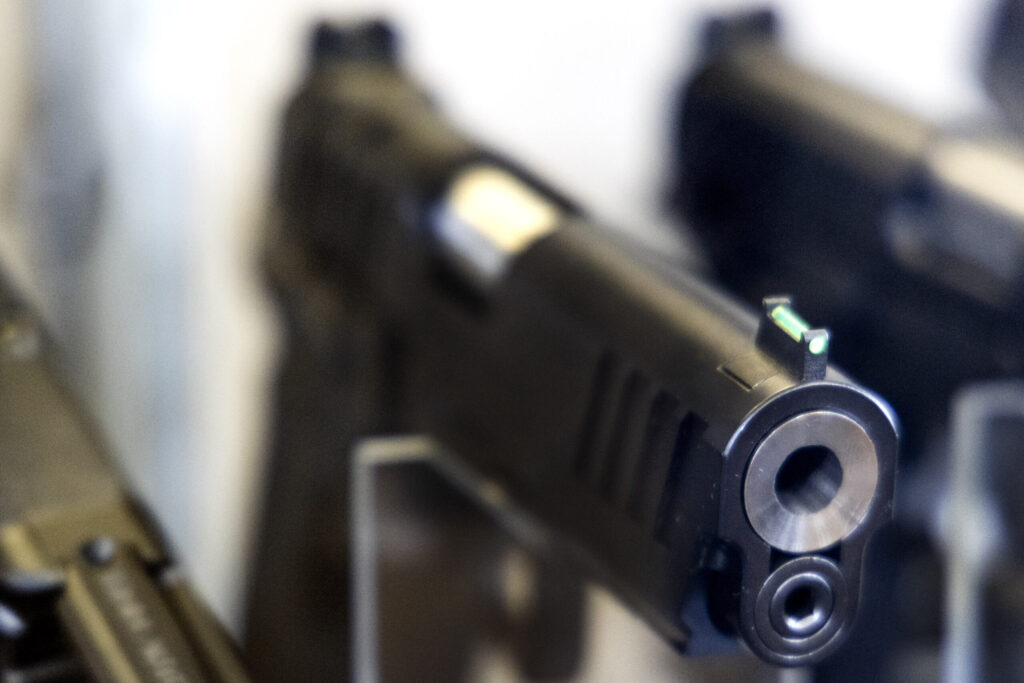
A gun on display in 2023 at Caso’s Gun-A-Rama in Jersey City, New Jersey. (Aristide Economopoulos/for NJ Monitor)
There’s only one reason gun manufacturers are donating about $2 million to a state-owned shooting range that will open this fall 10 miles north of Rapid City. It’s good business for them.
And that’s exactly why the South Dakota Department of Game, Fish & Parks, which will manage the facility, is wrong to welcome gun-industry donations.
I don’t know if spending $20 million to build one of the biggest publicly funded shooting ranges in the nation makes sense as an economic development tool or not. But I’m pretty sure the four gun-industry manufacturers that have pledged $1.9 million in donations to the project — Smith & Wesson, Glock, Aim-Point and Luth-AR — think it will mean bigger profits.
They will sell more of their product because their names are affiliated with this complex. That’s good news for them, but bad news for most everyone else. It’s bad because, despite the gun industry’s message that the more guns we own, the safer we will be, the truth is just the opposite. America is a country awash in guns, and all the research on gun violence shows that easy, largely uncontrolled access to guns puts all of us in greater danger of being a victim of gun violence.
Gun-industry companies and groups give $2 million to help build state-owned shooting range
In April, there were 1.2 million guns sold in the U.S. in just one month, according to the federal agency that tracks gun sales. Imagine the profit in those numbers, and the lengths gun companies will go to protect it. More than half of all the guns in private ownership in the world are in the U.S., yet Americans make up only 4% of the world’s population. Ever since 2020, the rate of gun ownership in the U.S. has been on the rise.
It should come as no surprise that we have experienced a corresponding rise in the rates of gun violence, especially in suicide rates, in that same time period, according to a new report on 2023 gun deaths by the Johns Hopkins Bloomberg School of Public Health. Nearly 80% of gun deaths in South Dakota are suicides, and recent laws passed by the South Dakota Legislature — such as those allowing concealed pistols on college campuses and in bars — may add to those numbers.
The majority of guns are purchased for reasons that have nothing to do with hunting or shooting sports, and everything to do with the marketing myths created by gun makers. Gun importers looking to sell huge stockpiles of cheap, surplus firearms left over in Europe after World War II found a wide-open market for them in America, and the rest is gun industry history.
I don’t doubt that the Meade County shooting sports complex will bring economic benefits to local tourism and hospitality sectors, as well as gun and sporting goods stores. Certainly the gun safety training it provides for youth is a good thing. Maybe the range will boost the state’s economy and justify the $13.5 million investment in taxpayer funds it received from the governor-controlled Future Fund. Or maybe it won’t. All that remains to be seen. The only gun owner at our house prefers to take a walk on public lands and shoot at real pheasants, not paper targets, so we won’t utilize the facility. The projected annual cost of running the facility — estimated at $355,000 — might become a burden to the state’s budget that we can ill afford.
I sympathize with Meade County ranchers and residents who oppose the shooting range. No doubt the sound of firearms discharging — from handguns to .50-caliber machine guns — in what is now quiet grasslands will degrade the quality of life on the surrounding ranches and small rural acreages. It raises concerns about the safety of their livestock and livelihoods, too. Plenty of state lawmakers seemed to agree with the ranchers, given the difficulty the shooting range had in securing state funding before former Gov. Kristi Noem circumvented the Legislature’s will.
Never miss new commentary: Sign up for our free newsletter.
Some state legislators say taking donations from the gun industry is bad politics. The critics are right, of course. The optics are bad. Legislators will appear beholden to gun industry interests in the future, given they helped fund a significant portion of a state-run enterprise. But here in South Dakota, the horse is already out of that particular barn.
The gun lobby hardly needs to purchase more influence with the South Dakota Legislature. Virtually any legislation supported by the gun industry, and the numerous organizations created to promote it, is guaranteed passage in this state. The gun culture is so entrenched here that few legislators dare to question it or support common-sense gun violence prevention legislation such as Red Flag and Secure Storage laws, policies designed to keep guns out of the hands of people who are too young, too untrained, or too emotionally or mentally unstable to buy them. Instead, they vote to welcome guns in bars and on college campuses.
As a South Dakota taxpayer, I’m opposed to taking funds from the gun industry simply because I don’t want to help them advertise and sell more of their lethal product. The 27 words that comprise the entirety of the Second Amendment speak about the right of citizens to “bear” and to “keep” arms, not any right of corporations to “sell” or “manufacture” or “market” them.
It’s clear our government has a responsibility to protect the constitutional rights of people to own firearms. But as a country, we have absolutely no responsibility to help the gun industry increase its profits, and we shouldn’t make deals that will do so.





